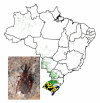Geographic distribution of chagas disease vectors in Brazil based on ecological niche modeling
- PMID: 22523500
- PMCID: PMC3317230
- DOI: 10.1155/2012/705326
Geographic distribution of chagas disease vectors in Brazil based on ecological niche modeling
Abstract
Although Brazil was declared free from Chagas disease transmission by the domestic vector Triatoma infestans, human acute cases are still being registered based on transmission by native triatomine species. For a better understanding of transmission risk, the geographic distribution of Brazilian triatomines was analyzed. Sixteen out of 62 Brazilian species that both occur in >20 municipalities and present synanthropic tendencies were modeled based on their ecological niches. Panstrongylus geniculatus and P. megistus showed broad ecological ranges, but most of the species sort out by the biome in which they are distributed: Rhodnius pictipes and R. robustus in the Amazon; R. neglectus, Triatoma sordida, and T. costalimai in the Cerrado; R. nasutus, P. lutzi, T. brasiliensis, T. pseudomaculata, T. melanocephala, and T. petrocchiae in the Caatinga; T. rubrovaria in the southern pampas; T. tibiamaculata and T. vitticeps in the Atlantic Forest. Although most occurrences were recorded in open areas (Cerrado and Caatinga), our results show that all environmental conditions in the country are favorable to one or more of the species analyzed, such that almost nowhere is Chagas transmission risk negligible.
Figures









References
-
- Chagas C. Nova tripanozomiase humana. Estudos sôbre a morfologia e o ciclo evolutivo de Schizotrypanum cruzi n. gen., n. sp. ajente etiolójico de nova entidade morbida do homem. Memorias do Instituto Oswaldo Cruz. 1909;1(1):159–218.
-
- Dias JCP, Silveira AC, Schofield CJ. The impact of Chagas disease control in Latin America—a review. Memorias do Instituto Oswaldo Cruz. 2002;97(5):603–612. - PubMed
-
- Miles MA. The discovery of Chagas disease: progress and prejudice. Infectious Disease Clinics of North America. 2004;18(2):247–260. - PubMed
-
- Coura JR, Viñas PA. Chagas disease: a new worldwide challenge. Nature. 2010;465(7301):S6–S7. - PubMed
-
- Schmunis GA, Yadon ZE. Chagas disease: a Latin American health problem becoming a world health problem. Acta Tropica. 2010;115(1-2):14–21. - PubMed
LinkOut - more resources
Full Text Sources

